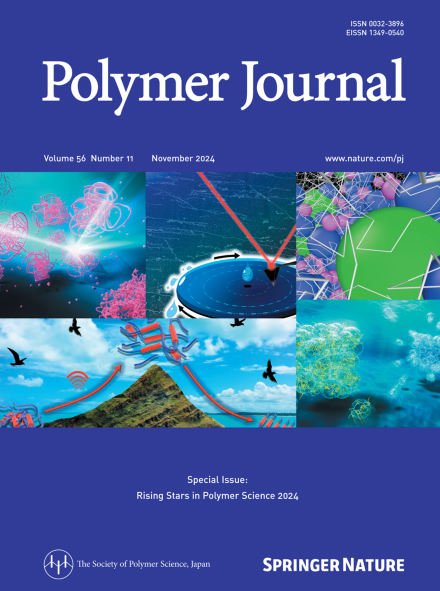Salt concentration dependency of the hydrated swollen structure of cholinephosphate-type polyzwitterion brushes
IF 2.3
4区 化学
Q3 POLYMER SCIENCE
引用次数: 0
Abstract
The swollen thicknesses of zwitterionic polymer brushes with phosphorylcholine (PC), cholinephosphate (CP), sulfobetaine, and carboxybetaine groups were measured in aqueous sodium chloride (NaCl) or calcium chloride (CaCl2) solutions via force curve measurements by scanning probe microscopy (SPM) and neutron reflectivity measurements. PC and CP have different charge positions in betaine units consisting of ammonium and phosphate. The PC-type polymer brush did not distinctly reduce the swollen thickness in either the NaCl or CaCl2 solution, even at 1000 mM. However, the swollen thickness of the CP-type polymer brushes was clearly reduced in the aqueous CaCl2 solution. Unlike the phosphate of PC, which is located inside the betaine unit, the phosphate of CP tends to form insoluble calcium phosphate, resulting in the collapse of the brush structure. The effect of calcium ion on the swelling structure of polymer brushes bearing phosphorylcholine (PC) and cholinephosphate (CP) groups in aqueous solution were investigated by scanning probe microscopy and neutron reflectivity measurements. The CP-type polymer brushes formed collapsed structure in the aqueous CaCl2 solution because the phosphate of CP, which is located outside the betaine unit, strongly interacts with calcium ions to form insoluble calcium phosphate. In contrast, no significant change was observed in the swollen thickness of the PC-type polymer brush in the aqueous CaCl2 solution.

磷酸胆碱型多两性刷水合膨胀结构的盐浓度依赖性
在氯化钠(NaCl)或氯化钙(CaCl2)水溶液中,通过扫描探针显微镜(SPM)测力曲线和中子反射率测量,测定了含有磷酸胆碱(PC)、磷酸胆碱(CP)、亚砜甜菜碱和羧甜菜碱基团的两性离子聚合物刷的膨胀厚度。在由铵和磷酸组成的甜菜碱单元中,PC和CP具有不同的电荷位置。pc型聚合物刷在NaCl或CaCl2溶液中,即使在1000 mM时,也没有明显减少肿胀厚度。然而,cp型聚合物刷的膨胀厚度在CaCl2水溶液中明显减小。与PC的磷酸盐位于甜菜碱单元内部不同,CP的磷酸盐倾向于形成不溶性磷酸钙,导致刷状结构崩溃。通过扫描探针显微镜和中子反射率测量,研究了钙离子对含磷胆碱(PC)和磷酸胆碱(CP)基团聚合物刷在水溶液中的溶胀结构的影响。CP型聚合物刷在CaCl2水溶液中形成塌缩结构,这是因为CP的磷酸盐位于甜菜碱单元外,与钙离子强烈相互作用,形成不溶性磷酸钙。相比之下,pc型聚合物刷在CaCl2水溶液中的膨胀厚度没有明显变化。
本文章由计算机程序翻译,如有差异,请以英文原文为准。
求助全文
约1分钟内获得全文
求助全文
来源期刊

Polymer Journal
化学-高分子科学
CiteScore
5.60
自引率
7.10%
发文量
131
审稿时长
2.5 months
期刊介绍:
Polymer Journal promotes research from all aspects of polymer science from anywhere in the world and aims to provide an integrated platform for scientific communication that assists the advancement of polymer science and related fields. The journal publishes Original Articles, Notes, Short Communications and Reviews.
Subject areas and topics of particular interest within the journal''s scope include, but are not limited to, those listed below:
Polymer synthesis and reactions
Polymer structures
Physical properties of polymers
Polymer surface and interfaces
Functional polymers
Supramolecular polymers
Self-assembled materials
Biopolymers and bio-related polymer materials
Polymer engineering.
 求助内容:
求助内容: 应助结果提醒方式:
应助结果提醒方式:


